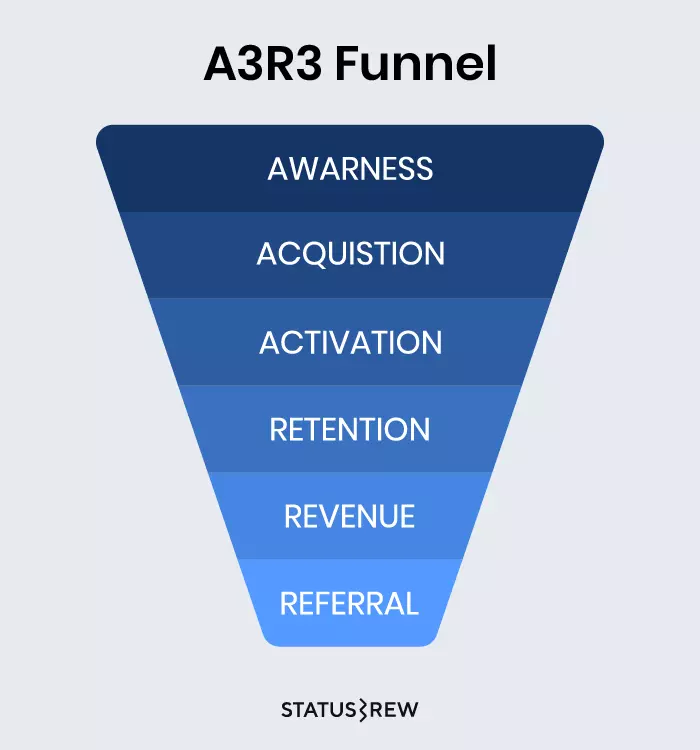Last week, while I was talking to a new intern, he asked me something: “If marketing means growth… isn’t all “marketing” growth marketing?”
And it got me thinking - “Is that the reason why almost everyone talking about marketing on LinkedIn uses it as a hashtag?”
I get it - “marketing” and “growth marketing” do sound the same - but unfortunately, they don’t mean the same, and… definitely do not work the same.
Let me break it down for you - what growth marketing really is, how it differs from traditional marketing, and more on this.
What is Growth Marketing?
Growth marketing is a strategic and data-driven approach to scale your business and convert leads. Unlike different marketing tactics, this approach is holistic and focuses on driving sustainable growth by nurturing loyal customer relationships, building a customized sales funnel, and planning specific goal-aligned campaigns.
Benefits of Growth Marketing?
If your goal is growth and you’re open to a marketing approach that focuses on data and experimentation, growth hacking is the way to go. Here are some key benefits of this approach (and reasons to invest in building your own growth marketing team).
Better ROI
In growth marketing, continuous testing, learning, and optimization means that businesses aren’t just playing by guesswork - it’s based on solid research and goals. By focusing on what works and discarding what doesn’t, companies can achieve a better return on their marketing investment and ensure that budgets are spent more efficiently.
Scalable
One of the key principles of growth marketing is its scalability. When a particular strategy or tactic proves to be effective, it can be scaled to reach a broader audience. This ensures that the marketing efforts are not just effective but efficient as well.
Customer Understanding
Growth marketing helps businesses to understand their customers better. As there is rigorous testing and continuous iteration in growth marketing, every brand gains insights into the preferences, behaviors and needs of the customers. The in-depth insights about the target audience help companies to deliver products/services that are at par with customers' needs.
Increases Customer Retention
Growth marketing involves creative campaigns that match the audience's needs, make them take interest and encourage them to engage with the brand. This, in turn, results in a long-term relationship when the customer becomes loyal to the brand by purchasing and returning to purchase.
SEO Enhancement
Growth marketing and SEO work in sync with a singular goal - to get more eyeballs to the brand and convert leads. You cannot get any fruitful results by choosing either one. For example, you have planned a top-notch growth marketing campaign, but your website is trashy and impossible to discover on search engines. Will the campaign bring positive results? No. If you want your campaigns to work, a good foundation of SEO is non-negotiable.
Difference Between Digital Marketing and Growth Marketing
| Digital Marketing | Growth Marketing |
|---|---|
| Focuses mostly on awareness and acquisition | Focuses on full-funnel marketing - which begins with awareness, and then goes on to acquisition, activation, retention, revenue, and finally ends with referral |
| Comes with a long-term plan | Has a more agile approach |
| Focuses on the company’s goals | Focuses on offering solutions to customers |
Top Growth Marketing Strategies Pro Marketers Use

1. Cross-channel marketing
In cross-channel marketing, the growth marketing manager focuses on building a strategic channel plan with a specific goal. Unlike traditional marketing, in cross-channel marketing, there’s more focus on first understanding the communication preferences of individual users and then designing the growth campaigns accordingly.
2. A/B testing
Among other growth marketing skills, marketers swear by A/B testing and serve as a foundational element within a robust strategy. It finds applications across various mediums, including email marketing, landing pages, social media advertisements, and more.
It allows you to experiment with different versions of your content, making changes to elements like graphics, text, design, and other factors to discover which variation resonates most effectively with your target audience and ultimately increases conversion rates. Once you identify the winning version, you can fine-tune your future marketing campaigns accordingly, using the insights gained from these tests to continually enhance your approach.
The customer lifecycle is the journey customers go through as they discover, engage with, purchase from, and reconnect with your company. It mainly consists of three key stages: activation, nurturing, and reactivation.
- Activation: This is the start, where companies aim to grab customers' attention and interest. They use welcome messages, trials, and introductory campaigns to establish credibility and familiarity.
- Nurturing: In this stage, companies build and strengthen relationships with customers. It involves ongoing marketing efforts like sales, promotions, newsletters, and updates.
- Reactivation: The final stage focuses on re-engaging customers to boost loyalty. Companies run campaigns like post-purchase, abandoned cart reminders, loyalty rewards, and win-back initiatives.
All stages of the growth marketing tactic are important, and customers move through them at their own pace, while marketers use tailored campaigns to meet their changing needs.
3. Lead Magnets
If you want to engage an audience, lead magnets happen to be one of the most effective ways to get your audience’s attention and encourage them to engage and take action. However, using anything as a lead magnet won’t work as it needs to be specifically something that your audience will find useful almost immediately - something that can solve the immediate problem they are facing.
4. Content Marketing
Growth marketing focuses on specific objectives across the customer journey. This means that content should be tailored for different stages: awareness, consideration, decision, and advocacy. For instance, blog posts can create awareness, while case studies might push for a decision.
Growth marketers analyze metrics to understand which content types and topics resonate most. This means regularly reviewing engagement metrics, conversion rates, and other KPIs to tailor future content accordingly.
5. Social Media
Growth marketers identify clear, measurable objectives that could range from brand awareness to driving sales. Once they know who their target audience is and their preferences, they analyze what content resonates best with their audience and iterate based on that.
Growth marketers ensure that content aligns with the brand's value proposition, leveraging various formats like videos, stories, polls, infographics, and carousel posts to engage the audience.
Step-by-Step Guide to Growth Marketing Using AAARRR (A3R3) Framework - From Awareness to Referral
What is the A3R3 Funnel?
The A3R3 funnel or growth funnel is one of the best growth marketing frameworks that focuses specifically on the customers and their pain points and takes data and technology into consideration to optimize the customer journey, generate more leads, and retain them longer.

Stage 1: Awareness
The A3R3 funnel begins with an awareness stage where the target audience is made aware of the product or solution.
Metrics used to measure: Clicks, Reach or Impressions, and Traffic or No. of visitors
Stage 2: Acquisition
In the second stage, that is, acquisition, the targeted audience takes an action and becomes a part of your warm leads - but the prospect is still not activated i.e they haven’t engaged with your product or service, yet.
Metrics used to measure: Leads, Enquiries, Subscriptions, Downloads, Email Captures
Stage 3: Activation
In the third stage, that is, activation, the audience starts using and engaging with your product or service - this stage can also be called as the lead nurturing stage.
Metrics used to measure: Demo signups, trial signups, freemium customers, sales responses
Stage 4: Retention
In the fourth stage, that is, retention, the audience who have engaged with your product or service and found it beneficial stays. You can also offer them offers at this stage to help them retain longer.
Metrics used to measure: Customer lifetime value, contract renewals, churn rate
Stage 5: Revenue
In the fifth stage, that is, revenue, the goal is to convert the nurtured, actionable, and engaged audience into paying customers. At this stage, there are ample upselling and cross-selling opportunities to encourage customers to spend their dollars.
Metrics used to measure: Subscriptions, no. of orders/purchases, trial to paid conversions
Stage 6: Referral
In the last stage, that is, referral, the goal is to get more new customers from the loyal customers in their network. That’s where networking and strong customer relationships play a huge role - you can also offer some incentives like extended trial periods or free products to get more referrals.
Metrics used to measure success include influencer sales, referral conversions, and social sharing, which can all be monitored through referral tracking software to optimize your strategies.
However, while the first two stages of the growth funnel, awareness and activation remain the same (no matter what your strategy is), the rest of the four stages keep on changing based on the strategy to the growth marketer and the type of audience they have.
For example, have you ever seen how Dropbox works when a new user signs up? Whenever a new user signs up, they offer them a double-sided referral program where the individual referring and as well as the one being referred to, derives the benefits.
So, as soon as the user goes through the Acquisition stage, Dropbox brings in the Referral stage. Such a strategy works perfectly for Dropbox because they already have an existing authority in the market and could come up with a lead magnet that hits exactly the audience’s pain point by solving their immediate cloud storage problems.
However, it’s not a mandatory strategy. While shuffling the activation stage with the referral stage worked for Dropbox with almost a 60% increase in signups, it might not work for you. So, assess your strategy first, and then customize your growth funnel accordingly.
How To Grow Your Business With A Successful Growth Marketing Strategy?
1. Set the Goals
Start by setting up relevant and achievable goals for your business - it's crucial to identify objectives that align seamlessly with your broader business vision.
For example, while an ecommerce company might have the goal of increasing their “Add to Cart” rates, for a B2B product company, the goal might be to get more sign ups.
2. Map Goals to Metric
Once you have found the goal, work on mapping your goal to the metrics. There is only one metric in growth marketing that makes a difference, known as the North Star metric.
The North Star metric is the single overall objective of your growth marketing strategy, unlike KPIs that happen to be much more specific. However, there are different OMTM metrics that contribute to achieving the single Noth Star.
For example, if your North Star metric is to achieve one million followers on Instagram, the OMTM can be to optimize hashtags for your Instagram posts or reels.
3. Research - Ask 10 Key Questions
Whichever OMTM you choose, you’ll have to do certain research and that’s where the 10 K Questionnaire comes in. Once you answer these ten questions, you’ll be able to clear the majority of doubts regarding your research.
Here are the top 10 questions to ask yourself first:
- What is your startup’s big goal for the next 6 months?
- If you were given 30 days to grow your startup, what would be the one metric you would focus on?
- What is the current strategy to achieve your desired goals?
- Who is your target customer?
- What would they / do they find most valuable in your offering?
- What are the current top 3 channels that you’re using to achieve your goal?
- Which social media / search channels does your target audience use the most?
- What other apps/services/platforms does the target audience subscribe to or use?
- Who are your closest competitors / direct competitors?
- Who are the influencers (individuals) in your space?
4. Ideate
After the research, next comes the ideation stage - where the real magic happens. The two of the most-used frameworks which help with the ideation process are 3Cs and 3Ps.
Here’s what 3C’s mean and how to use it:
-
First C stands for “Channels” where you need to make a list of the channels where your target audience tends to be most active.
-
Second C stands for “Competitor” where you make a list of all the competitors including direct and audience competitors.
-
Third C stands for “Communities” where you need to find all the comments related to your target audience’s discussions and posts to understand their pain points better.
Now that you know what the 3 C's stand for, let me tell you what the 3 P’s stand for too.
Here’s what 3P’s mean and how to use it:
-
First P stands for “Piggybacking” where you discover ways to enter target channels or communities and try to move the audience to your growth funnel.
-
Second P stands for “Partnership” where you need to explore opportunities for fruitful collaborations to achieve your OMTMs.
-
Third C stands for “Paid Opportunities” where you need to find paid targeting options like ads to achieve your OMTMs and increase your reach.
5. Leverage Growth Marketing Tools
Growth marketers often have to deal with multiple tasks on their plate - sometimes they are writing a copy, while sometimes they’re analyzing data. In such a situation third-party tools come as a savior. Wondering what kind of third-party tools you would need?
-
Landing page tools: If you are working on campaigns and want to drive traffic using landing pages, then tools like Unbounce, Instapage and Leadpages can be of great help. While Instapage comes with a bit of advanced and personalized features, you can start with Unbounce or Leadpages as they come with simple drag and drop functionality.
-
Analytics tools: You can start with our good old Google Analytics which not only gives you access to the flow of user interactions on your website but is also backed by multiple metrics, making it easy to run a thorough check. Besides that, there are also tools like Localytics and Segment which makes it easy to collect customer data and segment them instead of jumping to graphs directly.
-
Social listening tools: Before jumping into any social listening tool, you first need to know where your audience hangs out the most - and then choose a platform. Even though BuzzSumo comes with great features, at its core, it’s a content discovery tool.
However, the social listening tool Statusbrew is specifically designed to align with your social media marketing efforts and requirements, and offers better engagement features like Unified Inbox, Rule Builder for Sentiment Analysis, and Statusbrew Social CRM. While the Unified Inbox acts as your one-click access social inbox, the Statusbrew CRM assists you in getting contextual information about your customers during a conversation for better personalization and targeting.
6. Do Growth Sprints and Execute
Once you know which framework is working for you, you can try and execute growth sprints where each sprint is four weeks to six weeks. One particular goal is set for each sprint, and throughout the period of time, efforts are made to reach the goal through both lean and agile growth strategies. At the end of every sprint - reflect, measure, and improve the results to scale up.

Tailor Your Custom Growth Strategy Now!
So, now you know growth marketing is not just a trendy hashtag - it's a data-driven approach with a more holistic take to boost your business growth. While it shares certain similarities with the traditional marketing approach, growth marketing has its heart in customer nurturing. However, just like any strategy, it goes without saying that you need to tailor it according to your business goals and requirements and constantly reiterate it based on the results.
FAQs
1. Why is A/B testing important in growth marketing?
A/B testing gives growth marketers the opportunity to experiment and play with different versions of the same content. When they test out these multiple versions, they get a clarity on which version will be ideal.
2. What’s the difference between growth marketing and digital marketing?
Digital marketing majorly deals with the first two stages of the funnel, that is, awareness and acquisition. While growth marketing deals with the full funnel and includes all the stages till referrals.
3. How can I start with growth marketing?
You can start your brand’s growth marketing by setting clear objectives, mapping those objectives with respect to specific metrics, researching more and answering key questions regarding your business, planning strategies, and carrying out growth sprints.
4. Is Growth Marketing the same as Growth Hacking?
Growth marketing is a broader and more strategic approach to encompass the whole customer lifecycle. On the other hand, Growth hacking is a short-term approach using unconventional tactics to achieve rapid growth. However, they both share similar goals altogether!
5. For tracking growth marketing success, what are the metrics that are crucial?
To track growth marketing, you need some Key Performance Indicators (KPIs) like Lifetime Value (LTV), Customer Acquisition Cost (CAC), Churn Rate, Monthly Active Users (MAU), and Net Promoter Score (NPS).




Explore the Statusbrew range of social media tools
Cancel anytime!